
In his autobiography Shamus Culhane remembered Edith Vernick as a redheaded Russian. She was, in fact, Ukrainian, born in Kyiv on April 5, 1905 as Ida Wernick. Rebellion was in the air. Russia’s Tsar Nicholas II considered the Ukraine to be part of his Romanov Empire, and workers’ strikes originating in St. Petersburg had spread to Kyiv.
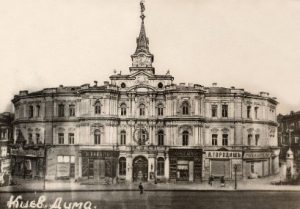 Nicholas blamed this unrest on the Ukrainians, particularly the Jews who lived there. Edith Vernick’s family were Orthodox Jews.
Nicholas blamed this unrest on the Ukrainians, particularly the Jews who lived there. Edith Vernick’s family were Orthodox Jews.
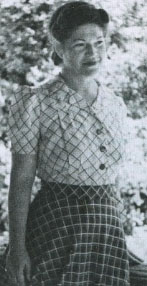 Sword wielding Cossacks on horseback carried out pogroms, murdering Jewish families in their homes. In 1907 the Vernicks escaped that barbarism by resettling in New York City. Edith turned out to be a headstrong, creative girl who loved to dance. Growing up near the bohemian Greenwich Village neighborhood may have influenced Edith’s course in life. She studied art at Washington Irving High School, taking a job at a lampshade factory upon graduation. In 1923 Out Of the Inkwell Films hired Edith. That company’s owner Max Fleischer had been born n to a Jewish family in Austrian controlled Poland not so very far from Kyiv, and may have felt an immediate kinship with the young woman. Fleischer’s daughter Ruth, a year younger than Edith, worked at the studio, and Max sort of adopted Edith.
Sword wielding Cossacks on horseback carried out pogroms, murdering Jewish families in their homes. In 1907 the Vernicks escaped that barbarism by resettling in New York City. Edith turned out to be a headstrong, creative girl who loved to dance. Growing up near the bohemian Greenwich Village neighborhood may have influenced Edith’s course in life. She studied art at Washington Irving High School, taking a job at a lampshade factory upon graduation. In 1923 Out Of the Inkwell Films hired Edith. That company’s owner Max Fleischer had been born n to a Jewish family in Austrian controlled Poland not so very far from Kyiv, and may have felt an immediate kinship with the young woman. Fleischer’s daughter Ruth, a year younger than Edith, worked at the studio, and Max sort of adopted Edith.
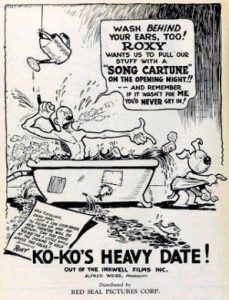 Out Of the Inkwell Films used the cut and slash method in those days. Edith would cut around the final inked versions of characters so they fit against the background drawings. Most of Fleischer’s output were Ko-Ko the Clown cartoons. Animator Dick Huemer came on board, upgrading the production values on Ko-Ko. Cels came into use, so Edith became a cel washer, then an opaque, on up to inker.
Out Of the Inkwell Films used the cut and slash method in those days. Edith would cut around the final inked versions of characters so they fit against the background drawings. Most of Fleischer’s output were Ko-Ko the Clown cartoons. Animator Dick Huemer came on board, upgrading the production values on Ko-Ko. Cels came into use, so Edith became a cel washer, then an opaque, on up to inker.
Ben Harrison, Manny Gould, and Burt Gillett were all at Fleischer Studios. They had been with Charles Bowers doing MUTT AND JEFF cartoons, but that series was on hiatus. Constant exposure to the salty talk of those animators taught Edith how to swear like the proverbial French sailor. In many ways she was one of the boys. When Harrison, Gould and Gillett returned to MUTT AND JEFF they staged a coup, establishing Associated Animators. Edith Vernick and Dick Huemer were invited to join the new venture. Max Fleischer felt Associated Animators used techniques he’d developed and filed for an injunction against them, naming Edith as a defendant. She returned to Max’s employ and his good graces.
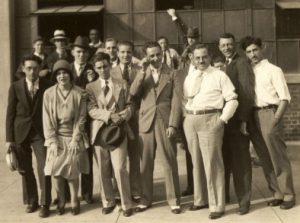 As Out Of the Inkwell Films turned into Inkwell Studios, Edith was there, steadfast through those lean years. Max Fleischer had money problems, but he was super smart, and likeable . . . There was no roadmap for cartooneries back then. This little band of artists were pioneers blazing trails. Max was their leader, and he did not disappoint.
As Out Of the Inkwell Films turned into Inkwell Studios, Edith was there, steadfast through those lean years. Max Fleischer had money problems, but he was super smart, and likeable . . . There was no roadmap for cartooneries back then. This little band of artists were pioneers blazing trails. Max was their leader, and he did not disappoint.
In 1929 Max secured financing from Paramount Pictures to open Fleischer Studios in Manhattan’s Times Square district.
He’d have a hundred employees, and counted on Edith Vernick to help with management. In 1931 she was put in charge of the new
inbetweeing department, answering directly to Max or his business agent Art Buchwald. There is no doubt she was a company girl.
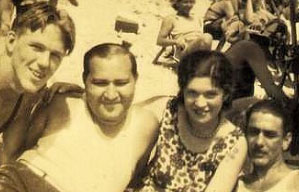 She’d go to the beach with Al Eugster and the other fellows. A nearby boardinghouse rented rooms to a few of Fleischer’s animator.
She’d go to the beach with Al Eugster and the other fellows. A nearby boardinghouse rented rooms to a few of Fleischer’s animator.
Edith lived there as well. The guys held a weekly card game with local prostitutes and bootleg liquor. Edith could match their foul-mouthed banter there at that brownstone, but warned them all to be on better behavior in front of the women at work.
Through her work Edith met movie executive Richard Murray, part of Paramount’s short films department. They became romantically involved around 1933. The mysteries of Edith’s love life were fodder for the studio newsletter FLEISCHER ANIMATED NEWS, which poked fun at everyone.
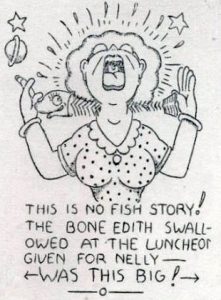 The only known biography of Edith Vernick appears in that newsletter and lies about everything as an April Fools joke. She lists her birth date as April 15, 1898 and claims to be a direct descendant of Russian nobility, who was summoned to dance before the Tsar at the age of fourteen.
The only known biography of Edith Vernick appears in that newsletter and lies about everything as an April Fools joke. She lists her birth date as April 15, 1898 and claims to be a direct descendant of Russian nobility, who was summoned to dance before the Tsar at the age of fourteen.
That, of course, led to her marrying the Romanov Prince. They fled with their child together when the Russian Revolution erupted. When they reached Englanf Edith’s husband got lost in the fog and she never saw him again. Upon reaching America, Edith gave her child away to a childless couple. That boy grew up to be inbetweener Jack Mercer.
The article also reported that her hair was a wig glued to Edith’s head because falling down a flight of stairs made her bald. Amusing as this all may be, there were a number of people who would like to see Edith fall down a flight of stairs. Among the one-hundred-and-sixty-five employees at Fleischer Studios, many were inbetweeners under her supervision. Every Friday Edith had dinner with Sam Buchwald and his wife at their home. She kept Buchwald informed on any transgression in her department, including talk of forming a union.
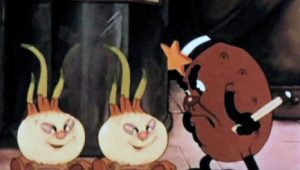 Edith Vernick regularly contributed humorous poetry to thenewsletter, considering herself one of the crowd, neverrealizing how unpopular her unwaivering support oh Max made her. She’d been branded a “snitch”. Backlash against Edith compelled Max to replace her as manager of inbetweeing. Edith was promoted to assistant animator. The only film posterity seems to recognize her working on is Fresh Vegetable Mystery, under Dave Tendlar’s supervision. She must have penciled for many others cartoons. When the strike to unionize hit Edith crossed the picket lineeach day to churn out pages at her drawing board.
Edith Vernick regularly contributed humorous poetry to thenewsletter, considering herself one of the crowd, neverrealizing how unpopular her unwaivering support oh Max made her. She’d been branded a “snitch”. Backlash against Edith compelled Max to replace her as manager of inbetweeing. Edith was promoted to assistant animator. The only film posterity seems to recognize her working on is Fresh Vegetable Mystery, under Dave Tendlar’s supervision. She must have penciled for many others cartoons. When the strike to unionize hit Edith crossed the picket lineeach day to churn out pages at her drawing board.
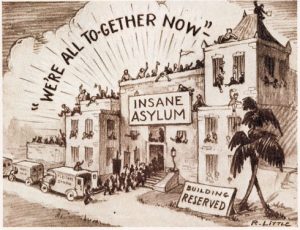 The strike stretched on. Eventually Paramount Pictures forced a settlement. Max decided to move Fleischer Studios to Miami, Florida. Those New York artists were mixed in with a bunch from Hollywood as Fleischer set to work on a feature length movie.
The strike stretched on. Eventually Paramount Pictures forced a settlement. Max decided to move Fleischer Studios to Miami, Florida. Those New York artists were mixed in with a bunch from Hollywood as Fleischer set to work on a feature length movie.
About seven hundred people were on the payroll in Miami.
When Walt Disney made SNOW WHITE AND THE SEVEN DWARFS, three men trained at Fleischer Studios were integral cogs in Disney’s machine. Grim Natwick, Al Eugster and James Culhane all added greatly to that first-ever American animated feature. Now they’d come home to help Max create the second. The great Bill Nolan was there with them.
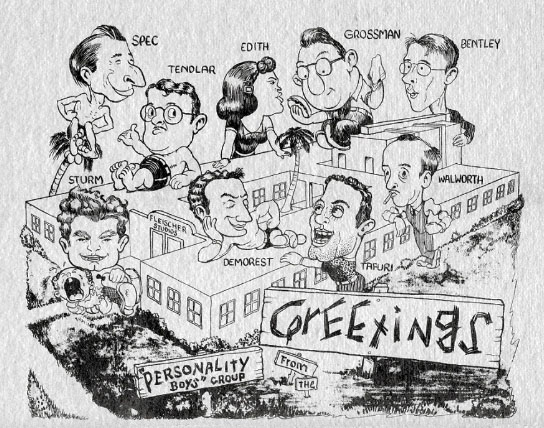
So were the cream of Fleischer’s New York Animators: Roland Crandall, Willard Bowsky, Orestes Calpini, Ben Clopton, 0tto Feuer, Seymour Kneitel, Myron Waldman, Bill Sturm, Nick Tafuri, Irv Spector, Sam Stimson, Frank Endres, Joe Oriolo, Ed Rehberg, and Steve Muffati. Meanwhile, Edith Vernick supervised the assistant animation department that included Ben Solomon and George Ottino. As they cranked out pages inbetweeners Woody Gelman, Joe Deneroff, and Larry Riley covertly kept the hope of unionizing the studio alive. They gave the World GULLIVER’S TRAVELS.
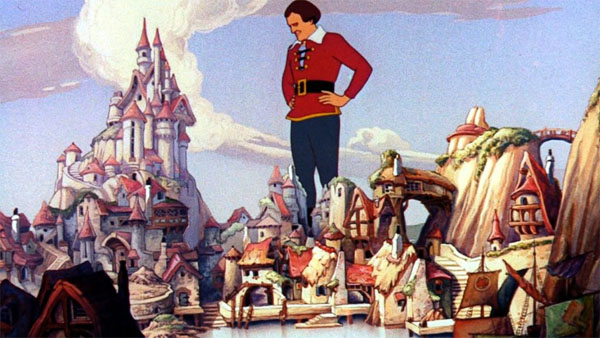
That Fleischer bunch played as hard as they worked. All that sun and fresh air took its toll. They’d drink on the beach. Edith danced. While she was gone from New York, Richard Murray ended their seven year relationship by marrying his secretary. To prove some point Edith married a “bum” she’d known two days. Miami was still a backwater then, mostly palm trees and alligators. The town bloomed into a city almost overnight when a Naval base was constructed there in 1940. Edith opened a restaurant. Neither her restaurant or her marriage lasted very long. Fleischer Studios made another animated feature called MR. BUG GOES TO TOWN.

Two days after MR. BUG GOES TO TOWN premiered in New York the U.S. was pulled into World War Two. Max owed Paramount a lot of money. Studio workers were laid off, stranded in Miami. Many of Edith’s male friends were drafted into the military. In 1942 Paramount Pictures foreclosed on Fleischer Studios. Max was gone. At thirty-seven years old Edith had spent half her life working for Max Fleischer. She decided to join the Army.
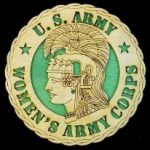 The newly formed Women’s Army Corps sent Edith to Des Moines, Iowa as the regimental artist doing posters,fliers, and working on a recruitment film. She was quickly promoted to full sergeant and stationed in California. Max Fleischer rewarded her long-time loyalty by sending Edith twenty-five dollars every week. She mustered out in summer 1945 as the war ended.
The newly formed Women’s Army Corps sent Edith to Des Moines, Iowa as the regimental artist doing posters,fliers, and working on a recruitment film. She was quickly promoted to full sergeant and stationed in California. Max Fleischer rewarded her long-time loyalty by sending Edith twenty-five dollars every week. She mustered out in summer 1945 as the war ended.
 After her enlistment Edith’s trail gets murky. She seems to have hung around California working for William Hanna and Joseph Barbera at M-G-M as a supervisor of assistant animators on the Tom & Jerry classic THE CAT CONCERTO. This would only be possible if Edith joined the Screen Cartoonists Guild. Inker Sydel, who Edith knew well from Fleischer Studios, was already at M-G-M. When Fleischer went to Miami, Sydel went to Hollywood. Sydel Solomon returned to New York by mid 1946, employed at Cineffects. Edith Vernick was back by early 1847, serving on the union local’s dance committee with Sydel.
After her enlistment Edith’s trail gets murky. She seems to have hung around California working for William Hanna and Joseph Barbera at M-G-M as a supervisor of assistant animators on the Tom & Jerry classic THE CAT CONCERTO. This would only be possible if Edith joined the Screen Cartoonists Guild. Inker Sydel, who Edith knew well from Fleischer Studios, was already at M-G-M. When Fleischer went to Miami, Sydel went to Hollywood. Sydel Solomon returned to New York by mid 1946, employed at Cineffects. Edith Vernick was back by early 1847, serving on the union local’s dance committee with Sydel.
Paramount Pictures had reestablished Fleischer Studios as Famous Studios, keeping Sam Buchwald on as business manager. It’s unclear whether or not Edith worked for Famous at that time. Buchwald resisted her return, possibly because if her conversion on the union issue. When Max Fleischer learned Edith became a member he wouldn’t speak to for years.
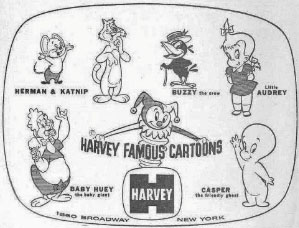 As a member of the local’s dance committee, Edith personally offered free dance lessons to any interested member. Edith also joined the American Veterans Committee’s Motion Picture Chapter, volunteering as a delegate to their convention in Chicago. Controversy continued to dog her, and in 1949 Edith resigned from the union local’s executive board for personal reasons. She did get elected as a trustee that summer, and soon went to work for Jack Zander at Transfilm.
As a member of the local’s dance committee, Edith personally offered free dance lessons to any interested member. Edith also joined the American Veterans Committee’s Motion Picture Chapter, volunteering as a delegate to their convention in Chicago. Controversy continued to dog her, and in 1949 Edith resigned from the union local’s executive board for personal reasons. She did get elected as a trustee that summer, and soon went to work for Jack Zander at Transfilm.
After several months with Zander, Edith went to Fletcher Smith Studios where Tex Hastings ran the animation department. Vernick and Hastings knew each other well from their pre-Miami days with Fleischer. Edith had just won the seat of Recording & Financial Secretary for Local 1461.
The next year Edith was with Shamus Culhane Productions. She’d been Shamus Culhane’s inbetweening supervisor back when he was still Jimmie and working for Fleischer. Now they made television commercials. Edith presented her song EVERYTHING IS OKIE DOKIE on the TV show SONGS FOR SALE in March of 1952. During summer break she decided to take a Carribean cruise.
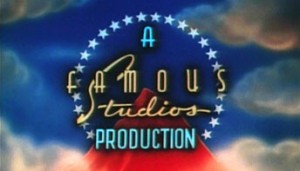 Projects at those small general service studios could be sporadic. Edith definitely joined Famous in 1953. Sam Buchwald had died of a heart attack. A few old faces were still around, but the whole atmosphere was different. Company policy barred personnel away in the military from visiting there while home on leave. Famous was best known for its POPEYE THE SAILOR series, and Edith must have worked on them. She won the seat of treasurer for Local 1461. As a Welfare Fund Trustee in 1955 she sought clarification of when union medical coverage kicked in. Paramount was selling off the old cartoons for television syndication. Rumors circulated that the studio would close. During vacation that year Edith visited studios in Chicago and Hollywood to review job prospects.
Projects at those small general service studios could be sporadic. Edith definitely joined Famous in 1953. Sam Buchwald had died of a heart attack. A few old faces were still around, but the whole atmosphere was different. Company policy barred personnel away in the military from visiting there while home on leave. Famous was best known for its POPEYE THE SAILOR series, and Edith must have worked on them. She won the seat of treasurer for Local 1461. As a Welfare Fund Trustee in 1955 she sought clarification of when union medical coverage kicked in. Paramount was selling off the old cartoons for television syndication. Rumors circulated that the studio would close. During vacation that year Edith visited studios in Chicago and Hollywood to review job prospects.
December 1955 found Edith Vernick once again in California at M-G-M, this time as a Checker. She worked closely with director Michael Lah on the Droopy Dog cartoon GRIN AND SHARE IT. When M-G-M got slow in June of 1956 Edith put in time with TV Spots making commercials at 1037 North Cole Avenue. Paul Sommer, director of animation at TV Spots, hailed from Terrytoons in New York, having been at Screen Gems with John Hubley and Frank Tashlin.
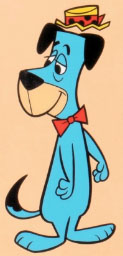 Edith was elected an officer in the SCG Hollywood local in 1957. She made her way over to Animation, Inc. at 8564 Melrose Avenue. The owner, Earl Klein, had been at Famous Studios while Edith was in the Army. At Animation, Inc Edith worked alongside Art Babbitt, and Arnold Gillespie, who she knew from GULLIVER’S TRAVELS. During the few months Edith worked for Klein M-G-M shut down its animation department. William Hanna, Joseph Barbera, and Michael Lah founded Hanna Barbera Productions, hiring Edith Vernick at the start of 1958 as THE HUCKLEBERRY HOUND SHOW geared up. She vacationed in Hawaii that year.
Edith was elected an officer in the SCG Hollywood local in 1957. She made her way over to Animation, Inc. at 8564 Melrose Avenue. The owner, Earl Klein, had been at Famous Studios while Edith was in the Army. At Animation, Inc Edith worked alongside Art Babbitt, and Arnold Gillespie, who she knew from GULLIVER’S TRAVELS. During the few months Edith worked for Klein M-G-M shut down its animation department. William Hanna, Joseph Barbera, and Michael Lah founded Hanna Barbera Productions, hiring Edith Vernick at the start of 1958 as THE HUCKLEBERRY HOUND SHOW geared up. She vacationed in Hawaii that year.
 In an interview Edith claimed that her final job in animation was with Larry Harmon Productions doing Bozo the Clown cartoons. When that gig ended she was on the outs, After forty years the industry she’d helped forge had passed her by. She attended business classes in stenotype, landing her a job as a file clerk at RCA, until layoffs happened there. Edith applied to instruct one of Hanna-Barbera’s training courses but got no response. She’d never really liked California and tried Washington D.C. for a change of pace.
In an interview Edith claimed that her final job in animation was with Larry Harmon Productions doing Bozo the Clown cartoons. When that gig ended she was on the outs, After forty years the industry she’d helped forge had passed her by. She attended business classes in stenotype, landing her a job as a file clerk at RCA, until layoffs happened there. Edith applied to instruct one of Hanna-Barbera’s training courses but got no response. She’d never really liked California and tried Washington D.C. for a change of pace.
 In November of 1965 Edith Vernick secured a job with the Federal Aviation Administration. They assigned her to the National Aviation Facilities Experimental Center in Galloway Township, New Jersey near Atlantic City. Edith Vernick finished out her career serving the country that had taken her in as a child.
In November of 1965 Edith Vernick secured a job with the Federal Aviation Administration. They assigned her to the National Aviation Facilities Experimental Center in Galloway Township, New Jersey near Atlantic City. Edith Vernick finished out her career serving the country that had taken her in as a child.
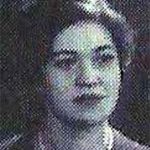 When the animation community honored those with decades of dedication to the animation industry in 1985, Edith Vernick received a Golden Award. She’d been involved almost from the start, laboring away beside giants of the field. This woman held her own in a business dominated by men. Her complex, hard driving persona influenced the course of Fleischer Studios, and therefore the business itself, yet so little is known about her. I don’t even know when Edith Vernick passed from this World, but I get a charge out of knowing she was in it.
When the animation community honored those with decades of dedication to the animation industry in 1985, Edith Vernick received a Golden Award. She’d been involved almost from the start, laboring away beside giants of the field. This woman held her own in a business dominated by men. Her complex, hard driving persona influenced the course of Fleischer Studios, and therefore the business itself, yet so little is known about her. I don’t even know when Edith Vernick passed from this World, but I get a charge out of knowing she was in it.


 BOB COAR made his way in this world as a muralist and sign painter, illustrating on just about every surface imaginable. A life-long fan of animation, he is currently searching for digital, or actual, copies of Top Cel.
BOB COAR made his way in this world as a muralist and sign painter, illustrating on just about every surface imaginable. A life-long fan of animation, he is currently searching for digital, or actual, copies of Top Cel. 



































Great writeup!
Winding up with Bozo is not the greatest way to go out, but a cool career nonetheless.
Yeah I find it pretty awkward to go out with a CLOWN, but I agree she had a phenomenal career.
Edith Vernick died on May 25th 1992 in Atlantic City, New Jersey.
The 1940 census (which butchers her name) lists her as being an artist at an animated cartoon studio, earning $3,000 per year. Highest education was 3rd year of high school, age listed as 35 (consistent with a 1905 birth date). Single, born in Russia, and had been living in Manhattan in 1935.
The 1925 New York State census has her as living in the US for 18 years (implying a 1907 move), lists her profession as “artist,” lists her as an alien (i.e., she hadn’t been naturalized, yet), and she was living at 569 West 150th Street (Hamilton Heights) with her sister Rebecca, and her father Aaron, who appears to have been a widower and a bookkepper.
There’s some indication that she married a William Weston Schultz on August 19, 1941 in Miami; his draft card from October, 1940 has him working at a Child’s Restaurant in Miami. They were divorced in 1942 — short marriage. He was inducted into the army (his records indicate he’d been a cook in private life) in March of 1942. He died (apparently in combat) in the Netherlands in March of 1945, as a member of the 17th Airborne Division, and is buried there. He had subsequently remarried.
Edith was mustered in at Camp Blanding (the same camp as her ex-husband) in October of 1942, and was listed as divorced.
There are indications her full name was Edith Ida Vernick.
Wonderful piece! Terrific research on an unsung figure!
Vernick is buried in Arneytown, NJ which is near Trenton. She was born a year later than indicated from what I can find, in 1906 (and on April 18th. 13 days prior to that is April 5 which makes sense as Russia was still on the Julian Calendar until 1918.
https://www.findagrave.com/memorial/156736296/edith-ida-vernick
This is a very interesting article. I had read Edith Vernick’s name in passing but knew nothing of her personal background or career post-Fleischer.
That’s the old Duma building in Kyiv with the statue of St. Michael the Archangel on top. It was destroyed during World War Two. Since Ukrainian independence other statues of St. Michael have been raised in Kyiv, for example on the gate at Independence Square, holding a shield and sword in his role as patron and protector of the city. Good luck to him.
So in the late 1970s I traveled to Atlantic City to interview Edith. I had been warned by Myron and Rosalie Waldman that she was a character. They recounted how she once dyed her hair and what was used turned her hair green. That created some drama at the studio. Edith was indeed a character insisting I have some flat soda and stale Doritos in her small apartment. She was full of stories including how she once got her dress wet while at the Inkwell Studios and took it off to dry it. This posed a problem when Max was showing someone around the studio. She looked at me and said she had worked for Larry Harmon. “Larry Harmon was a schmuck. Do you know what a schmuck is, Michael? A schmuck is a penis. Larry Harmon is a penis.” Myron said that she simply couldn’t keep up the pace required of animators at the studio.
Mike, was she wrong about Larry Harmon? Not from what I’ve heard!
Thanks for all the feedback and further info. All I can add at this point is the follow-up that in 1940 our girl resided in Coral Gables at 1520 Salzedo Street.
A great article on Edith! I worked under her while at Famous Studios (the successor to Fleischer Studios). I believe she was probably the first woman at any studio in the U.S. to provide animation for an animated film- since it was long considered that women were not capable of the creative work required for animation (this was true for generally ALL U.S. animation studios at that time). While there she worked her way up to the Supervisor of the in-between department, meaning she oversaw the creation of drawings ‘in-between’ the main drawings. The article is correct that she was known for her liberal use of ‘salty language.’ Plus, Historian Ray Pointer said that ‘inbetweeners’ working for her had to raise their hands to request restroom breaks. However, she was so talented she actually did a bit of animation (though it was uncredited)- one of the films she’s said to have done some animated for was “The Fresh Vegetable Mystery,” made in 1939. You won’t see her name in the credits, since it was the usual rule at the Studio at the time to give screen credit to only two names. Years later (1960’s? 70?’s) when I was living in Washington, DC I got a call from Edith who was then working for the Federal Aviation Administration in the DC area. We got together– same old Edith! So nice to see her remembered here!
Ginny, what was Edith’s job title at Famous? I would like to interview you.
Edith Vernick was my dad’s aunt. As a child, when she visited us, she would always entertain us with amazing drawings of Popeye and Olive Oyl. I am familiar with some of what is mentioned in this fascinating article, but I never had such detailed knowledge of her bio before reading this. She is missed for sure!
And Edith Vernick was my Mom’s aunt too! (Joe Vernick’s daughter, Mildred, was my mom.) I remember her well. She was a wonderful character. And you and I are cousins, obviously, Elliot!